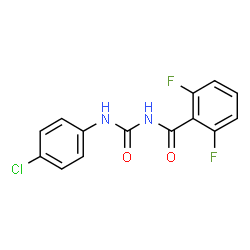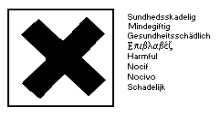Diflubenzuron
Diflubenzuron (Difluron, Dioflubenzuron, Dimilin, C14H9ClF2N2O2, CAS#35367-38-5, 'N-[(4-chlorophenyl)carbamoyl]-2,6-difluorobenzamide') is the harbinger of all the BPUs and has been extensively studied and used around the world. It is highly insoluble in water and has to be ingested to be effective. It is not systemic in plants and therefore does not work on sap-sucking insects. Although one would expect that it should be effective on all open feeding lepidopteran larvae it is not uniformly effective and this could be due to detoxification in some species. Species such as the fruit tortrix moths Adoxophyes orana, and Pandemis heparana are relatively insensitive to diflubenzuron (Eck, 1981). In the spruce budworm, C. fumiferana, larvae in the fifth and sixth stadia were more susceptible to diflubenzuron than in the earlier stages (Granett and Retnakaran, 1977). Some species like the forest tent caterpillar, Malacosoma disstria, and the gypsy moth, Lymantria dispar, are very sensitive to this compound (Retnakaran et al., 1985). It has been used to control cockroaches, locusts, grasshoppers and most leaf-feeding larvae, in general (Weiland et al., 2002).
Uses
Insect pests of cotton, soyabean and horticultural crops are all susceptible. Larvae of sciarid flies, phorid flies on mushrooms, mosquitoes and most fly larvae can all be controlled with diflubenzuron. In veterinary applications, feed through trials on cattle led to the control of the house fly larvae (Musca domestica) in the dung. Diflubenzuron is less effective on the Colorado potato beetle, Leptinotarsa decemlineata, than lufenuron or hexaflumuron.
Diflubenzuron products can come in many forms, including liquids, granules, dusts, and pellets. Other products are used in aquatic settings like birdbaths and ponds. Some materials are infused with pyriproxyfen, such as pet flea collars. Products with pyriproxyfen often include other insecticides to kill adult insects.
Package & Transport
Package Size: N.W: 20/24 Kg G.W: 25/29 Kg;
UN Number: 3077
Hazard Class: 6.1
Notice
1. Avoid mixture with food and forage, and avoid reach of children.
2. Use respirator and glove when handling, clean completely with soap and water when splashed into skin.
3. Destroy and bury waste drum or dip it into alkali liquid for several days for recycling uses.
4. Storage in dry, cold area and avoid light.
Diflubenzuron
 |
|
| Molecular Formula | C14H9ClF2N2O2 |
| Molar Mass | 310.68 g/mol |
IUPAC Name
Identifiers
SMILES[show]
InChI[show]
Properties
| Appearance | Off-white to yellow crystals |
| Density | 1.57 g/cm3 |
| Melting point | 239 ℃ |
| Boiling point | 257 ℃ at 300 mm Hg |
| Vapour pressure | 1.33 x 10-5 Pa at 22.8°C |
| Solubility in water | 0.08 mg/l |

 English
English 中文简体
中文简体





 Arabic
Arabic  French
French  Italian
Italian  German
German  Japanese
Japanese  Korean
Korean  Portuguese
Portuguese  Russian
Russian  Spanish
Spanish 